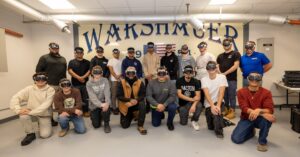Successful onboarding is the key to higher employee retention, increased commitment to the job, and more engaged workers who feel invested in the goals of the company. Integrating the benefits of digital work instructions—especially today’s technology-driven options—can also help employers trim onramp time, which smooths out the learning curve and brings workers to full productivity more efficiently. How can simply using the right tools assist field technicians during an indispensable phase of their development?
Research shows that empowering new hires is one of the most important elements of the onramping process. According to one 2023 study, three in four workers believe that having excellent access to information builds that sense of empowerment and is critical to their productivity. The study showed that workers want to resolve problems quickly without having to ask for help.
Going beyond basic digital instruction models, searchable 3D instructions deliver more comprehensive troubleshooting that can elevate the performance of a newly trained field tech— without needing assistance from a manager or veteran worker.
As employers look to improve their onboarding system and generate engagement among new employees, tapping the benefits of digital work instructions is essential for field technicians in any industry. Read on to see how next-generation instructions are changing onboarding for good.
How the Benefits of Digital Work Instructions Address Today’s Challenges
Despite the clear importance of onboarding, many companies don’t meet employee expectations with their current processes. One recent survey showed that only 52% of employees are happy with the onboarding process. Smaller businesses are even more likely to have new hires who are unsatisfied with the training they’re offered. For field technicians heading out to install or service products for end users, this is a troubling setup that can have a variety of negative effects.
Many of the problems stem from employees feeling under trained or lacking support. Some of the main issues associated with being poorly trained or unsupported include:
- Decreased employee retention. Many employees who feel they are undertrained lack confidence in their position and are ready to look for another job. Inferior onboarding can lead to a jump in turnover.
- Costly disengagement. Poor onboarding leads to disengaged employees. A 2020 Gallup survey showed that unengaged employees cost the business about 18% of the worker’s salary. A 2023 follow-up Gallup survey on productivity projected that companies worldwide would lose nearly $9 trillion due to disengagement this year.
- Difficulty recruiting. Word spreads quickly about sub-par onboarding processes. As employers compete for the attention of new field technicians, they can have a hard time overcoming an onramp viewed in a negative light.
- Mistakes with customers. Onboarding successfully, especially with the benefits of digital work instructions, increases the chances of a confident field tech, smooth install or repair, and happy customer, enhancing a company’s reputation and revenue. Contrarily, field techs who are not fully prepared by onboarding can hinder customer retention. Even well-trained employees need appropriate support in the field, particularly early in their employment.
- Clarity issues on brands or products. Manufacturers need to know their product instructions will be carried out correctly by the techs in the field. Advanced digital instructions on an accessible platform ensure that information is as up-to-date as possible during onboarding and afterward.
To overcome onboarding obstacles, employers need to understand today’s workforce and deliver an onramp process that will help employees seamlessly turn the corner. Consistently reevaluating a company’s onboarding system and adding new tools can help employees succeed.
Using 3D Digital Instructions to Rise Above the Trend
While inadequate onboarding creates a host of negative outcomes, strong onboarding led by a top-tier digital infrastructure makes a meaningful difference. Positive onramp experiences help employees overcome the 45-day window—the time when workers are most likely to quit—and lead to much lengthier employment overall.
The best digital platforms are ideally suited to helping new hires become successful employees. Tools like cloud-based, multisensory 3D instructions are as invaluable in the post-training process as they are during an employee’s initiation into the company.
Related: Why Instructions Matter: A Metrics-Based Review of How Instructions Impact Consumers and Brands
The best options allow field techs to zoom and rotate the 3D image of a product, easily search for keywords, and learn how to problem-solve efficiently before going to their first job. By addressing multiple modes of learning, field techs can more easily comprehend, remember, and put into practice what they’ve learned. Following onboarding, employees know they have the tools to fully visualize every aspect of the product before, during, and after an installation or service call—so any issues can be addressed clearly and efficiently.
This type of support creates a superb digital infrastructure that enhances new-hire confidence. Employers who can build that confidence with reliable instructions have a significant edge when it comes to retaining employees and increasing productivity.
Improving Ramp Time with Hands-On, Interactive Instructions
Clear communication and direct hands-on experience are two pillars of any successful onboarding system. The more productive the hands-on elements of a training program are, the faster an employee can develop the skills necessary to do the job. An effective instruction platform can directly impact the length of the onboarding process in multiple ways.
Faster Searches
We’re all used to finding quick answers, which is why paper instructions are nearly obsolete for field technicians. When a tech is in training or in the field, they need answers directly at their fingertips. New hires utilizing easy-to-search and manipulate digital instructions will grasp concepts faster in the training phase and will have a much easier time making the pivot when onboarding is complete.
Better Visualization
Just like students, most employees in training tend to be visual learners. They are not only more likely to benefit from visuals but they also like to self-learn. This is where more advanced models can bring on the full benefits of digital work instructions.
3D instruction platforms provide an immersive visual experience that caters to the shortcuts embedded in most of our brains. By combining the hands-on approach with an ideal system for self-learning, 3D instructions can help new hires learn faster and retain information better than more traditional approaches.
Avoiding the Limitations of Video
Training videos can still have plenty of value when it comes to establishing work culture and expectations. In terms of building skills, however, video training has stark limitations that can extend ramp time and frustrate new field technicians. That’s because videos don’t have the interactive capabilities that can elevate a new hire’s understanding of a product.
Related: The Genius(es) Behind Intelligent Instructions
Instead of pausing and rewinding repeatedly to comprehend a product from the limited perspective offered by a training video, digital work instructions can lead trainees directly to the solution. The ability to pinpoint a process or resolution efficiently in the onboarding process helps employees trust the process and gain new levels of empowerment.
Updating is a Breeze Instead of a Costly Problem
Both paper and video-based instructions can lead to another issue: an inconvenient updating process. Digital tools don’t require reprinting or reshooting—both of which are expensive and cumbersome. Many companies simply can’t keep up with model updates if they are using only traditional training tools. This leads to using outdated materials or forces companies to add addendums to the instructions. In either case, the onboarding process can be slowed down or rendered less effective while costing more than adaptable digital alternatives.
More Benefits of Going Digital: Appealing to the Next Generation of Employees
A training program needs to be regularly evaluated and improved in order to maintain its effectiveness with new employees. Field technicians from younger generations are especially accustomed to advanced, readily accessible digital tools. Mediocre or sub-par digital infrastructure can be a red flag to new employees beginning the onboarding process. Having a capable digital system supporting a training program helps younger employees see the company in a modern, positive light, improving engagement and productivity.
Another part of appealing to the next generation of field techs is capturing the full power of digital mobility. New employees want to be able to self-learn from anywhere, which can mean sidestepping connection issues. 3D, interactive digital instructions that can be downloaded directly to a phone, tablet, or other work device allow workers to access all the information they need from anywhere. This provides a boost during training and helps field techs overcome network issues at remote work sites.
All these attributes create a positive environment for learning, informational retention, and improving on the job. For teams that need to upskill or re-onboard, the advanced learning mechanisms of digital instructions will also save time and elevate employee performance. Employers and managers can set the tone by providing a toolkit that will encourage young employees to start their careers while aiding older employees who need to adapt to new models and products.
Related: The Ultimate Guide to Work Instruction Software for Manufacturing: Enhancing Training and Operational Enablement
Offering a Full Sensory Experience
The best digital instructions also cater to our full learning capacity. While a majority of us are visual learners, we actually learn best with a combination of different sensory experiences. This is why static PDFs have such limited value. They may help as a reference point, but they do not imprint the information on our brains the same way more dynamic visual tools do. We’re at our best when we can learn from a combination of visual, audio, and kinesthetic elements.
This points to the advantages of truly immersive 3D instructions. Trainees can manipulate the visual perspective of the product but are also able to see animated demonstrations. Instead of being limited by a static visual or a standard video, 3D instructions can harness the full potential of the visual learning experience while adding tactile and auditory elements as well. Employees enjoy a superior learning environment that comes with a built-in support system after they complete training.
Get Started with the 3D Digital Tool That Can Upgrade Your Onboarding Process
Creating a high-quality onboarding system that can adapt as you go requires utilizing today’s top digital platforms. One of the best ways to train field technicians is by giving them innovative digital materials like highly interactive 3D instructions to facilitate the learning process. An industry leader, BILT can transform paper instructions or manufacturer’s CAD into immersive 3D instructions that are ideal for onboarding and training in the classroom and on the go. BILT’s easy-to-master app allows users to quickly access the most up-to-date product instructions and move forward with total confidence. To see how 3D instructions can make your onramp process more efficient, productive, and even inspiring, contact our team for more information.



